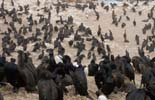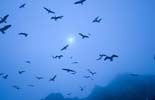 |
 |
 |
| Camp Pendleton | ||||||||
|
||||||||
 |
||||||||
 |
||||||||
Farallon Islands National Wildlife Refuge
For the Sanctuary book project, DSF worked to document and chronicle critical efforts by the U.S. Fish & Wildlife Service and the National Park Service. With the generous assistance of Joelle Buffa, former manager of the Farallon National Wildlife Refuge and supervisor of the biology program for the San Francisco Bay National Wildlife Refuge system, DSF was permitted to put ashore at the Farallones, one of theleast frequented and most important seabird breeding regions in the United States (outside of Alaska.) Here some two hundred thousand Common Murres, as well as Cassin's Auklets, Brandt, Double Crested and Pelagic Cormorants, Pigeon Guillemots, Tufted Puffins, Rhinoceros Auklets, and Western Gulls are to be found: at least 300,000 breeding birds in the month of July. One also finds the so-called "vagrants." Over 400 species of birds have been found at the Farallones. In addition, there are five species of pinnipeds: the California Sea Lion, Steller Sea Lion, Harvest Seal, Northern Elephant Seal and Northern Fur Seal. And, there are the four species of sharks guarding the islands, including Great Whites, Leopard, Blue and Soupfin, plus big whales, dolphins and porpoises.
Twenty-eight miles due West of the Golden Gate Bridge, this is one of the crown jewels of the U.S. Fish & Wildlife Refuge system and it is emblematic of the whole Wildlife Refuge concept as first envisioned and put into place by President Teddy Roosevelt.
It was also in the Bay Area - at the John Muir House in Martinez and Muir Woods in Marine County - that DSF profiled that great co-founder of the Sierra Club, and advocate for the protection of Yosemite and Hetch Hetchy, John Muir, for the Sanctuary book.
The Farallon Islands National Wildlife Refuge, California

